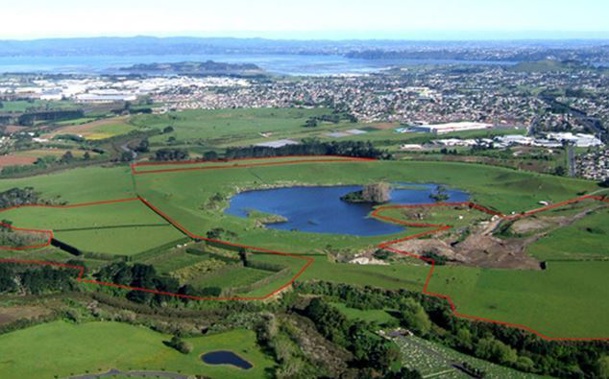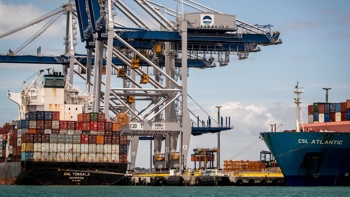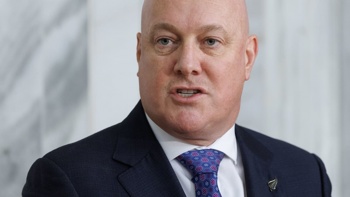
One of Auckland's last remaining volcanoes has been saved from development by a very narrow margin, but another contentious site may be a step closer to being developed.
Councillors have voted 10 to 9 against building around 500 homes in the area as part of the Crater Hill volcanic field, under the region's 30-year Unitary Plan.
LISTEN: Building homes on a volcano
They've instead sided with the advice of council staff, and a petition signed by several geologists and hundreds of other people.
Geologist Bruce Hayward said Crater Hill is geologically significant, and considered one of Auckland's most important volcanic areas and a potential world heritage site.
He's disappointed almost half of councillors were willing to rezone it.
"One of Auckland's volcanoes shouldn't have houses built inside or past it's crater so I'm a rather disappointed there were nine out of the Council who didn't see it that way."
"It's the last of Auckland's volcanoes that wasn't developed and our last chance to perhaps redress some of the damage that has been to so many others of our volcanoes in Auckland."
1. Crater Hill and Pukaki Peninsula won't be rezoned for development
The independent hearings panel recommended rezoning most of Crater Hill and Pukaki Peninsula at Puhinui. It argued the soils at Pukaki were not particularly fertile for agricultural production and housing could still be allowed on the Crater Hill volcanic field while protecting the crater itself.
Council staff disagreed with these recommendations. They said the entire Crater Hill and Pukaki Peninsula area was significant to local iwi and hapu, Crater Hill was geologically significant and Pukaki contained elite soils. They also said Pukaki could face high noise levels from overhead aircraft if Auckland Airport builds its second runway.
A slim majority of councillors have supported saving Crater Hill and Pukaki Peninsula in Puhinui, based on the council's advice.
Here is the #UnitaryPlan vote on NOT opening up Crater Hill and Pukaki Peninsula to development. @NewstalkZB pic.twitter.com/fzNQqGaEKb
— Michael Sergel (@michaelsergel) August 12, 2016
2. Clevedon Waterways will be rezoned for development
The independent hearings panel argued for rezoning Clevedon Waterways, to allow for a canal-style residential development in the future. Council planners advised councillors to reject that proposal to allow a canal development, because the council had local Treaty of Waitangi claim by Nga Tai and coastal erosion concerns.
Mayor Len Brown said he has been following the long-running debate about developing the waterways, and he was very surprised the independent hearings had suggested the rezoning.
"Anyway who's slightly interested in issues of stormwater development will know how this is. We're actually doing significant small village development in and around Clevedon already and dealing with the issues of storm water and wastewater. Given what we've got in the rest of our developmental opportunities in the south, we do not need to be pushing the boundaries out on this issue."
Councillor Chris Darby said rezoning the land could allow development to occur, without "allowing a fair process for the Crown to negotiate with Nga Tai on this settlement in this area". He said "this might go to appeal, and by that time those Treaty settlement issues might be addressed, but at this stage we don't."
Local Franklin councillor Bill Cashmore said the development had been approved by Manukau City Council but rejected by the Environment Court, and rezoning the land would not necessarily allow the development to occur.
"It has to go yet through a raft of very difficult tests, including iwi, engineering and stormwater. So the panel must have passed it for a very good reason to let it face those tests. The panel has listened to all its submitters and it's made its decision based on that. Although it might be problematic for me, troubling, I think it should be able to face those tests."
Here is the #UnitaryPlan vote on NOT opening up Clevedon estuary to development, which lost. @NewstalkZB pic.twitter.com/d4T7KeGIWv
— Michael Sergel (@michaelsergel) August 12, 2016
3. Councilors have voted against small apartments and big buildings
Most councillors have voted against allowing three or four dwelling buildings to be built without resource consents in residential zones. They also voted against the deletion of minimum dwelling size standards, following a previous vote on central city apartments, and voted against amending boundary height controls in residential zones.
Councillors have also refused to delete water and wastewater capacity standards and the definition of building coverage, following technical advice from council staff.
4. Auckland may never grow all of its own food
A majority of councillors supported removing security of food supply as an objective for rural areas, including landscape and biodiversity values as objectives, and not giving potentially infertile prime soils the same protection as elite soils like the Bombay Hills.
However, councilors opposed recommendations of the hearings panel designed to make it easier to subdivide rural properties. Instead, they voted to keep policies preventing inappropriate subdivision, promoting the significant enhancement of indigenous biodiversity, and allowing title to be transferred into the countryside living "lifestyle block" zone and not into other zones.
They also rejected recommendations to enable sporadic and scattered rural subdivisions,allow minimal environment benefits to be accepted in exchange for rural-residential subdivision, and potential subdividing on Caldwells Road in Whitford.
Councillors agreed to changes to the Waitakere Ranges Heritage Overlay, to allow some subdivisions in unprotected areas, and creating separate rural zones for the ranges and foothills to open more of the foothills up to subdivision. They decided not to put these rules in both the regional and district plan, based on the advice of council staff.
5. The city is set to grow south and west
A majority of councillors supported extending the Rural Urban Boundary in the south to include Pararekau and Kuahingahinga Islands, and rezone Pararekau from lifestyle blocks to single homes. They also agreed to change the underlying zoning of Clevedon Waterways. However, they rejected opening Crater Hill and the Pukaki Peninsula up to development.
Councillors agreed to extend the rural urban boundary at three locations in the Waitakere Ranges in Swanson, Henderson and Oratia. They fixed technical errors with thee Redhills and Westgate Precincts, scrapped the Milford 2 and Sylvia Park precincts, and kept the Takapuna 2 precinct. They decided to keep the AUT Akoranga and AUT precincts separate and asked for more information before making decisions about Okura.
6. Warkworth, Silverdale and Wainui are set to become much bigger
In far north Auckland, councillors agreed to extend the rural urban boundary at several locations around Silverdale from north of Hatfields Bech to Dairy Flat, and create a new Hatfields Beach precinct. They agreed to rezone part of the Wainui Future Urban zone to an urban zone. And they agreed to rezone more areas in and around Warkworth urban, light industrial, general business and countryside living. The results. This could allow Wainui to grow more rapidly, and new cities to emerge at Warkworth and Silverdale.
Councillors agreed to remove the Gulf Harbour precinct and rezone land from mixed housing suburban to terraced and apartment buildings. However, they also agreed to remove two Riverhead precincts and rezone future urban zone land to countryside living land, preventing subdivisions. They also fixed up technical errors relating to the Wainui precinct and Kumeu showgrounds, and rejected a large lot zone for a property at Snells Beach.
7. People are being saved from floods, and trees are being saved from people
The independent hearings panel defined very broadly. Councillors agreed to change the status of activities within flood hazard areas, but refused to increase the 1% annual exceedance probability flood hazard with 2% probability. They also disagreed with scrapping controls for new buildings or existing buildings in floodplains, removing coastal storm inundation maps, and removing the consent requirement for buildings at risk of coastal inundation.
A majority of councillors voted to keep all notable trees on the schedule of notable trees, and not to allow trimming of 20% of notable trees live growth as a permitted activity under certain conditions. These were both recommendations of the independent hearings panel. Councillors voted against increasing the permitted threshold for the trimming and alteration of trees in streets and public spaces, even when there is a tree management plan and particular conditions have been met.
Councillors kept in objectives to manage the adverse effects of infrastructure and tagging infrastructure objectives as regional coastal provisions, and rejected allowing vehicle charging stations on roads. They voted to delete standards for minor infrastructure,
8. Councillors generally sided with the advice of council planners
The councillors voted against including contaminated land in the accidental discovery control provisions, changing discharge rules, and removing the definition of land containing high levels of contaminants. They also voted to keep a differentiation between clean fill material and managed fills. Similarly, they rejected the independent hearing panel's recommendation to remove Kauri dieback provisions.
Councillors voted against the standards on vegetation removal within significant ecological areas to roads in those areas, decided not to include roadworks earth filling standards to floodplains and overland flow paths, and limiting earthworks within overlays for road network activities.
Take your Radio, Podcasts and Music with you









